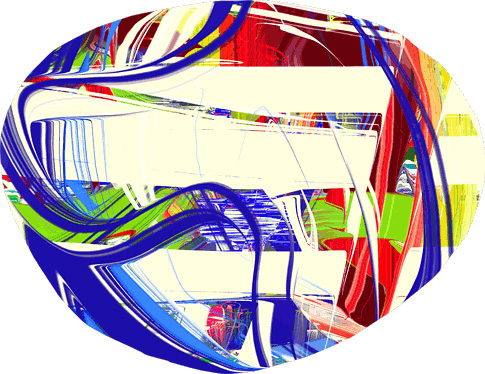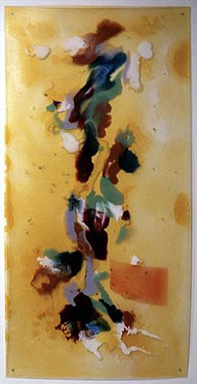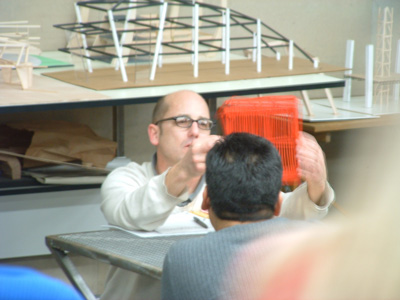August 13, 2005
Admin/MailCall/Tots*
The Comments are still out of commission for the meantime, that's alright by me. I don't miss the insidiously neccessary despamming chores. People chime in via email (the address is to your left in the margin), and that's been working out fine.
The comment function will be restored soon enough, reliant as I am for the help of a good friend for this fix. I told him no worries, to do it as his own pace, and I meant it.
Tranquilo, hombre. No pasa nada.
In terms of blogging, this is an ideal blogger's summer vacation -not having to clean spam drek every day.
***
I hope you don't mind the use of the boilerplate, it's extremely useful and it leads to themed posts. While providing a thematic stability, provides as well a radical flexibility (the Ahoras, the Zardoz's and the Yes's, for example).
I'm having fun.
Now, for the Mail Call:
Artist Claire Covey writes in:
Hi, I love your work and have been a fan for awhile. I just saw your posting
about Mullers article from a few years ago and was wondering if you knew
where I could read the whole article.By the way, if you can, you may want to clean off all the porno posts that
now follow your original Feb 13 post at
http://www.dennishollingsworth.us/archives/000214.htmlBest,
Claire Corey
I'll have to dig around for the article, everything is flying around like Dorothy's house at the moment.
About the comment spam ("porno posts"): they're nasty, aren't they? I've got to take some time to go though each post and remove each one. Assuming that it would take a second to click through each spam (estimating a small figure of 300 actual comments to subtract from the overall figure) and approximately thirty seconds to cycle through each archived post, at 773 entries would result in a little less than eleven hours or roughly, a hard day's work. A day of clicking like a monkey... no, a chicken pecking for corn. (Monkeys would tear up the house first)
I don't like feeling like a chicken pecking for corn. Or fleas.
But I guess I'll have to do it someday. Buh.
But what's nice is that I can click back into Clair's email address and find her website. It was a nice surprise to find great stuff:

She's just had a show in Amsterdam, maybe I can find her gallery there and see what I can. A nice adventure.
Here's the first paragraph of her review from a 2004 show at Ten in One Gallery:
Since 1995, Claire Corey has been composing her paintings on a computer. Once the image has been improvised on-screen, Corey has it printed onto a small canvas in colored inks. She then decides whether to have the painting executed in a larger format. Surprisingly, the work has its own brand of immediacy, thanks to the hint of a weave visible in the canvas and the slight physicality of the inks. Visually, the works resemble infinitely lapidary Color Field paintings.What I like beyond the Lasker/Herzog "Frozen Spontenaeity" of her work is that her once remove into the computer gives her a scalar freedom that I wish I had. I'd like to dig further into her site to find out how she breeds the slap happy (A term I use to describe my work too -in self deprecation and a frank acknowledgement of the visual dynamics although comically implied-, so I mean it as a compliment). I look forward to meeting her when I get to NYC this Fall.
***
Artist Greg Card is generous to give a thumbs up on the recent "Red" and "Yellow" (not the ultimate names of the paintings):
Kudos on your recent "yellow" and the "red", their visual sense is accute>>>
and got me to thinking about some things of mine from the early 70's, here's an example:

"Who's Question " 1971
cast resin and fiberglass
95 x 48 inches
Reeling in the years, I thought of all that happened in the art world since the beginning of the seventies and I asked him if it was Joan Mitchell that he was looking at...
most likely I was paying little attention to anyone in particular, maybe Larry Poons or Ron Davis.Thanks, greg.
Mitchell never got much of my attention, she always seemed too indirect or maybe that should be overworked, I always had a feeling of frustration looking at her efforts>>>
Now, I get to relook at Mitchell's paintings, looking for Greg's critical eye.
***
A blast from my past: Old friend Chuck Crawford writes in, it seems he found the blog. He sends me some pics:

Chuck and I went to undergraduate school together and afterwards we co-edited a 'zine called "Church of Architecture". He's in San Diego now, together with several other friends there (most from our school days in San Luis Obispo): Robin Brisebois, Jim Brown, Jim Gates, Ted Smith and Kathy McCormick from "Smith and Others". I hope to blog more about them soon, a very rich vien to mine there.

The great thing about this web is how people can reconnect.
***
Someone new writes in, Bernice Yan:
Hey. I was reading your blog entry on May 18, 2005 about the Joan Didion's quote in The White Album, and I was wondering if you could further explain "We live in phantasmagoria but we move through it by freezing it... then breaking it... so that we may freeze it again in another way." because I'm not quite getting it. Please email me back. Thank you.Thanks for asking and thus sending me back into the archives (to be chilled by finding mistakes... wuh. I don't know how I mixed Danto into the whole post except that somehow I feel that Kuspit and Danto are similar creatures in the art world).
When I used to teach figure drawing (not too much of it, maybe four classes in all back in the day), I used to try to get the students to realize the infinity of sensations as they gaze upon the model, and how they had the task of matching this infinite sea of sensations with the finite world of charcol-meets-paper. Their choices governed how much their minds and then other minds registered their marks and associated their marks with the object of their sensations. More over, the marks selected would convey their own mindset, their relation to this object in the world.
In one exercise, I would set up a still life with a cubic form at the top of the pile and look for how many students would draw the aspect they couldn't see (the top of the cube). this is classical Betty Edwards' "Drawing from the Right Side of the Brain" stuff, good for training students to take responsibility for what they see... or don't see.
My point here: we usually see the world in cartoons, assumptions and old figures drawn when we first "drew the world" as we grow into the world. Much of this is practical. It's a tough task to see the world as an infinitude of sensations (maybe we never do it), and living in an unfilitered phantasmogoria might be impossible. In order to move through the world we have to figure it out, but these figures we draw are ultimately cartoons, caricatures of what is really there (there was a BBC show about the Brain last year, good stuff, basic contemporary brain research... that show highlighted how the brain is wired to see via caricatures). Important cartoons, critical tools, life and death issues, indispensable. Ultimately, cartoons.
The trick to to break the old version and form a new one. As time changes, society changes and since social structures form around system sustaining sets of cartoons, we have a natural resistance to altering the staus quo. But all staus quos ultimately live a lie as they violate the modern "To be modern is to reconcile the life one lives with the things one makes." (my definition).
Break the old version, form a new one. Do it again. Do it again. That's how we grow, that's how we move through the world.
Suppleness.
Does any of this make sense to you, Bernice?
***
*"Tots" is Catalan for "All" or "Todo" in Castellano
Posted by Dennis at August 13, 2005 5:58 PM
Leave a comment